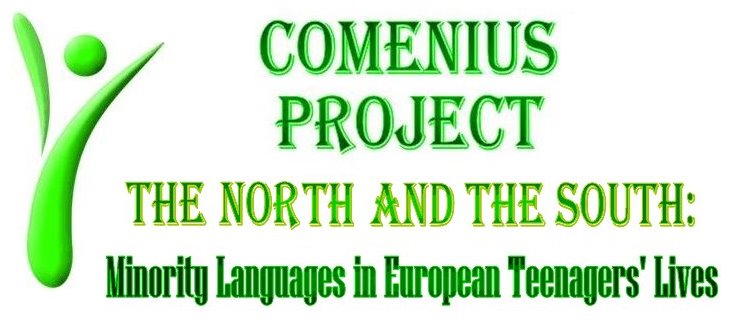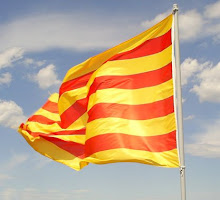WELCOME SPEECH
Hello and good morning! We are Sofia and Clara and we would like to welcome you to our school, not on behalf of the Comenius students but from all the students in the school.
We are very happy to have you here with us and to be able to work with you in this interesting project. We know that there is hard work to do, but we hope we will enjoy this time together and at the end it will be a great experience.
We also wish you a very exciting time in Barcelona. We hope you feel comfortable here in spite of the differences between our city and Haparanda. We would like to say that if you have any problem, don’t be shy, just tell us and we will try to help you as well as we can!
Now, we want to thank all the Swedish and Catalan teachers for working so hard to make this possible and giving us the opportunity to take part in it. The Comenius is a really good chance for us to get in touch with people from a very different and distant country and improve our English and knowledge.
Finally we want to say again that it’s fantastic to have you in our homes and share them with you, and we hope that you enjoy the activities prepared and that the experience is as good as you expected.
We wish you again a wonderful stay in Barcelona and that you can make it a bit of your own home!
That’s all from us. Have a nice day!
Sofia & Clara
FOOTBALL IN SPAIN
I’m here to tell you some things about football because it’s the most important sport that exists in my country. The majority of the Spanish people know important things about football because it’s very usual to talk about this here. There are other sports but they aren’t as famous as football, for example; basketball, handball and hockey to name a few.
Football can move millions and millions of money and millions and millions of people. A lot of teams or football clubs spend a lot of money on good players. Most of the important clubs in Spain also spend this money on young players at our age ( not as much as the older players if we see the professional teams).
Most Spanish boys, when they are young, play football and it´s their illusion and their dream. Most of them dream to be a famous football player one day. I don’t know if in Sweden it’s the same dream for the young Swedish boys or not…you will explain to me later if you want.
Ok, the league, our league, LFP, liga de futbol professional(in Spanish, professional football league,(translated into English), ),our league and it consists of 20 teams, 38 games for every team each year, and it has got the best derby around the world, F.C. Barcelona versus R. Madrid. These games are the most spectacular and exciting games that you can watch in your life.
Moving on to another topic. Bars in which the fans watch their teams play.
It’s a typical aspect of football in Spain,the full bars when some famous team plays, it’s a good experience and you have to attend one of these bars. For some people it can be stressful (if you don’t like football) because usually people smoke a lot and all the bar is full of smoke and people are always shouting… it can be fun and stressing at the same time!
- Catalonian Teams
There are two important teams in Catalonia that you need to know, they are as follows; FCB, the majority of you know this already, and the other team, the rival team of Barça is always present, when they play there is another “derby”, its name is Espanyol. The most important player of Barça nowadays is Lionel Messi, who most of you would know and for Espanyol, it is Raul Tamudo.
- Famous Swedish players known in Spain
Ibrahimovich and Henrik Larsson are the two most popular players known in Spain, especially Henrik Larsson because all Barcelona fans love him. So, we know these players and something else, I hope you know we are European champions and Xavi Hernandez is the best European football player ( a Catalonian …) …Xavi is from Barcelona team too, ( I have to say it because, here, there are the two best Barcelona fans… my teachers…and I have to say it to keep a good relation with them, ok?)
I want to tell you a paragraph about the meaning of football for us, ok??
First,in Spanish and I’m going to translate this afterwards:
"La Liga sabe diferente. La Liga es otra cosa. La Liga sabe a domingo, aunque se juegue en miércoles. Sabe a caravana de vuelta escuchando la radio, y a lunes en el trabajo. Sabe a nombres curiosos, como los de los árbitros, siempre con sus dos apellidos: Undiano Mallenco, Condón Uriz, Mejuto González. Y los estadios: Lasesarre, los Pajaritos, la Nova Creu Alta, la Condomina,. La liga sabe a cinco de la tarde, a Derbi, a nervios, a partido de infarto, a cábalas, al cuento de la lechera y la cuenta de la vieja. La Liga es la Liga. Si no has ganado una Liga, no has ganado nada. La Liga en la tele; la Liga en la radio; la Liga en el campo. Como en el campo, en ningún otro sitio, donde la Liga huele a hierba, y a cal, y a red. La Liga es la vida."
“The league has a special taste. The League is another element. You can feel the freedom of a bright sunny Sunday when watching the games. When the results are commented on the radio you can feel the satisfaction or disappointment that the players feel. There is a sense of curiosity as so many famous names are mentioned on the television, large names, names with many surnames: Undiano Mallenco, Mejuto Gonzalez,... . The stadiums’names are also well-known too and bring back so many memories to the fans: Lasesarre, los Pajaritos, la Nova Creu Alta, la Condomina. When a derby is played, you can feel the competition that the players feel. The league is THE league. If you have not won a league, you have not won anything. The league on TV, the league on the radio; the league on the field.
Nowhere else can the feeling or the smell of fresh cut grass be found but on the pitch… In La Liga.
…] Football is not a game in Spain, it´s life [ …] thank youuuuuuu!!!
Eloi
CASTELLERS
Today, Amanda and me are going to tell you about “Castellers”. This consists on a catalan tradition in which people who belong to a group climb ones upon others to finally build a human tower with different levels of difficulty.
It has its origins in the traditional valencian dance in which people performed dance, music and finally a human tower. Obviously, we can tell that this has ended up in beeing just the towering part, as the main and most important part.
Each tower consists on tree parts: “La pinya” in this part we place a great number of people who will be in charge of supporting and lifting the tower, it acts as the fundation.
An other remarcable part is the: “tronc”, the visible part of the tower, the one that lifts to the air. There are two more supporting parts: The “folre” which helps the “pinya” to support the “tronc” and the “manilles”, a group of people placed on top of the “folre” to help in the supporting of the highest steps of the “tronc”.
Typical casteller’s clothing consists of white trousers, a black sash (faixa), a bandana (mocador) and a shirt, that changes it’s colour depending on the team. For example, the Barcelona’s Castellers wear a red shirt while the Vilafranca’s Castellers have a green one.
The sash is the most important part of their outfit, because it makes force in the lower back and is also very useful for other castellers to hold their foot or hands while they are climbing up the tower. This piece changes in length and width depending on the casteller's position inside the tower and on his or her personal “taste”. It’s length can be between 1.5 meters and 8 meters. It’s usually shorter for those who climb higher up in the castell. Performing castellers usually go barefoot so that they do not hurt each other as they climb and so that they have more sensitivity in their feet.
The castellers arrange themselves into a structure with different tiered, sometimes as high as nine or ten people. A young child known as enxaneta climbs to the top of the tower. Accidents are unusual, but they sometimes occur: on 2006 a young casteller in Mataró fell off the castell she was forming and she died, but before this, the last fatal accident was in 1981.
Amanda


